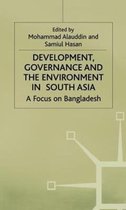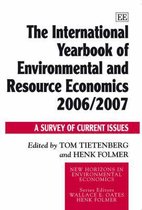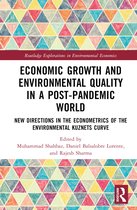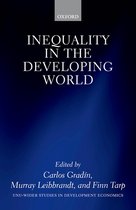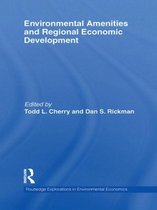International development in focus- Opportunities for environmentally healthy, inclusive, and resilient growth in Mexico's Yucatân Peninsula
Afbeeldingen
Sla de afbeeldingen overArtikel vergelijken
Auteur:
World Bank
- Engels
- Paperback
- 9781464813573
- 30 juni 2019
- 139 pagina's
Samenvatting
Mexico's Yucatán Peninsula faces growing risks from environmental hazards. Oil spills, hurricanes, coral bleaching, extreme flooding, and erosion have all been experienced over the past decade. This report explores selected topics that aim to inform decision-making in the region.
Approximately 4.1 million people live in the three states of the Yucatân Peninsula: Quintana Roo, Yucatân, and Campeche. Some 30 municipalities are in a coastal territory of almost 2,000 linear kilometers, spanning the oil fields of the Gulf of Mexico to the world-renowned beaches of Cancân, just north of the second-largest barrier reef in the world. The peninsula's natural assets also include notable Mayan temples. With poverty far from eliminated, and economic development opportunities beckoning in agriculture, manufacturing, and hydrocarbon development, the region faces growing risks from environmental hazards. Oil spills, hurricanes, coral bleaching, extreme flooding, and erosion have all been experienced over the past decade. Based on preliminary identification of environmental priorities, this report explores selected topics that aim to inform decision-making in the region. A general context of integrated coastal zone management is used to explore issues, constraints, and potential solutions. The role of geomorphology is examined with a view to identifying how shore management plans can contribute to improved coastal management. Economic studies find that the main environmental health risks in the peninsula result in more than 1,000 premature deaths every year and in more than 9.36 million days lost to illnesses. These risks generate substantial economic losses, representing 2.2-3.3 percent of gross regional income. Scenarios relating to the economic cost of extreme weather events generate similar levels of damages: 1.4-1.5 percent of GDP in 2020 and 1.6-2.3 percent of GDP in 2050. A social accounting matrix examines the social and environmental interconnectedness to the various parts of the economy. An institutional analysis considers the mandates of existing institutions in the states, and of the potential role that regulatory measures may contribute to environmentally sustainable development without undermining economic growth prospects. The report concludes with options for consideration in the years ahead.
Approximately 4.1 million people live in the three states of the Yucatân Peninsula: Quintana Roo, Yucatân, and Campeche. Some 30 municipalities are in a coastal territory of almost 2,000 linear kilometers, spanning the oil fields of the Gulf of Mexico to the world-renowned beaches of Cancân, just north of the second-largest barrier reef in the world. The peninsula's natural assets also include notable Mayan temples. With poverty far from eliminated, and economic development opportunities beckoning in agriculture, manufacturing, and hydrocarbon development, the region faces growing risks from environmental hazards. Oil spills, hurricanes, coral bleaching, extreme flooding, and erosion have all been experienced over the past decade. Based on preliminary identification of environmental priorities, this report explores selected topics that aim to inform decision-making in the region. A general context of integrated coastal zone management is used to explore issues, constraints, and potential solutions. The role of geomorphology is examined with a view to identifying how shore management plans can contribute to improved coastal management. Economic studies find that the main environmental health risks in the peninsula result in more than 1,000 premature deaths every year and in more than 9.36 million days lost to illnesses. These risks generate substantial economic losses, representing 2.2-3.3 percent of gross regional income. Scenarios relating to the economic cost of extreme weather events generate similar levels of damages: 1.4-1.5 percent of GDP in 2020 and 1.6-2.3 percent of GDP in 2050. A social accounting matrix examines the social and environmental interconnectedness to the various parts of the economy. An institutional analysis considers the mandates of existing institutions in the states, and of the potential role that regulatory measures may contribute to environmentally sustainable development without undermining economic growth prospects. The report concludes with options for consideration in the years ahead.
Productspecificaties
Wij vonden geen specificaties voor jouw zoekopdracht '{SEARCH}'.
Inhoud
- Taal
- en
- Bindwijze
- Paperback
- Oorspronkelijke releasedatum
- 30 juni 2019
- Aantal pagina's
- 139
- Illustraties
- Nee
Betrokkenen
- Hoofdauteur
- World Bank
- Hoofdredacteur
- Ernesto Sanchez-Triana
- Tweede Redacteur
- Jack Ruitenbeek
- Co Redacteur
- Katharina Siegmann
- Hoofduitgeverij
- World Bank Publications
Overige kenmerken
- Extra groot lettertype
- Nee
- Product lengte
- 280 mm
- Studieboek
- Nee
- Verpakking breedte
- 216 mm
- Verpakking hoogte
- 280 mm
- Verpakking lengte
- 280 mm
- Verpakkingsgewicht
- 165 g
EAN
- EAN
- 9781464813573
Je vindt dit artikel in
- Categorieën
- Boek, ebook of luisterboek?
- Boek
- Taal
- Engels
- Beschikbaarheid
- Leverbaar
- Studieboek of algemeen
- Algemene boeken
Kies gewenste uitvoering
Bindwijze
: Paperback
Prijsinformatie en bestellen
De prijs van dit product is 37 euro en 99 cent.
Uiterlijk 1 juni in huis
Verkoop door bol
- Prijs inclusief verzendkosten, verstuurd door bol
- Ophalen bij een bol afhaalpunt mogelijk
- 30 dagen bedenktijd en gratis retourneren
- Dag en nacht klantenservice
Rapporteer dit artikel
Je wilt melding doen van illegale inhoud over dit artikel:
- Ik wil melding doen als klant
- Ik wil melding doen als autoriteit of trusted flagger
- Ik wil melding doen als partner
- Ik wil melding doen als merkhouder
Geen klant, autoriteit, trusted flagger, merkhouder of partner? Gebruik dan onderstaande link om melding te doen.
